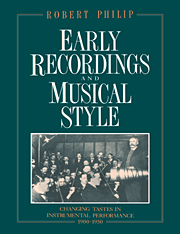Summary
INTRODUCTION
The development of modern vibrato on stringed instruments during the twentieth century is part of a general trend towards greater power and intensity. Vibrato is the most obvious element in the trend, and therefore the most important, but it is also closely linked to the other principal changes in string-playing – changes in the material of the strings, in styles of bowing, and in phrasing and articulation.
At the turn of the century, stringed instruments were still generally strung with gut, the lower strings overwound with metal (preferably silver). Steel E strings on the violin were becoming available by the 1890s, and according to Carl Flesch they were coming into more general use after World War I. By the 1920s Flesch was expressing the view that the difference in tone-colour between gut and metal was 'hardly noticeable', though arguments against the steel strings continued throughout the 1920s. There were two reasons for adopting metal strings: greater reliability and greater power. Their reliability was uncontroversial, but the greater power which they made possible was not approved of by all players. At late as 1938 a diatribe against steel strings was published, with the title Recovery or Ruin of the Art of Violin Playing (The Steel String, Enemy of Art).
- Type
- Chapter
- Information
- Early Recordings and Musical StyleChanging Tastes in Instrumental Performance, 1900–1950, pp. 97 - 108Publisher: Cambridge University PressPrint publication year: 1992

